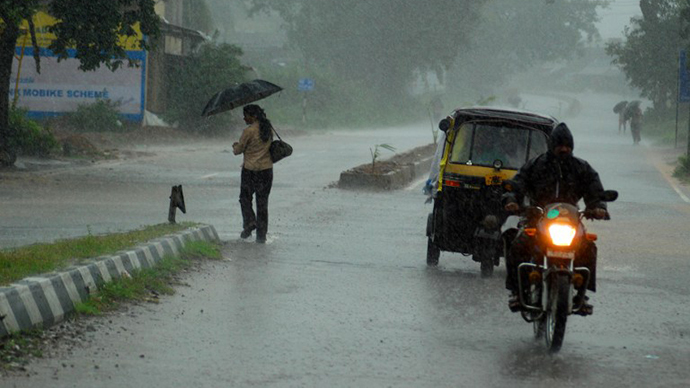'Red alert': Monster cyclone hits Indian coast, sends 550,000 fleeing
Published time: October 12, 2013 05:34
Edited time: October 13, 2013 00:09
Edited time: October 13, 2013 00:09

As one of the largest cyclones in India’s history has reached its eastern coast, prompting a national red alert and sending some 550,000 people scurrying for shelter, the first deaths have been reported.
Five people were killed in Odisha when trees uprooted by wind gusts fell on them, local media cited police officials as saying.

Cyclone Phailin is likely to be the strongest to hit India since 1999, when a deadly Orissa cyclone killed 10,000 people and caused $4.5 billion worth of damage. This cyclone may surpass that one, as it gathers strength over the warm water of the Bay of Bengal on its way toward land.
Heavy rain and strong winds of up to 220 kilometers per hour were already lashing the country’s eastern coast on Saturday morning as the cyclone approached. Television footage showed gusts of wind snapping branches from trees and residents of coastal villages flocking to shelters.
Hurricane Central ✔ @twc_hurricane
"This is one of the largest evacuations undertaken in India," said Shashidhar Reddy, vice chairman of the National Disaster Management Authority. "We will be on a war footing."
"We've been instructed by the government to use force in case people resist," Pradipta Mohapatra, Orissa state special relief commissioner, told AFP.
Paradip, a major port in Odisha, Andhra Pradesh, was closed and vessels ordered to sail to the open sea in the wake of the storm. Among them is an oil tanker holding about 2 million barrels of crude.
The US Navy's weather service estimated the wind at sea was gusting at 314 kilometers per hour, with some forecasters comparing the cyclone to Hurricane Katrina, which devastated New Orleans in 2005.
Read More Here
*********************************************************
India cyclone: 12m people face mass disruption as Phailin makes landfall
Severe storm hits Odisha and Andhra Pradesh states on east coast
Three people have been declared dead and rain and winds of at least 137mph continued to lash the east coast on Saturday while hundreds of thousands of inhabitants fled to higher ground or cyclone shelters. The Indian government issued a red alert and warned that the storm, which fills most of the bay of Bengal, could inflict serious damage when it made landfall.
More than 600,000 people had been moved to safety from India's eastern coastline on Friday as cyclone Phailin was classified as a supercyclone.
Roads were all but empty on Saturday as high waves lashed the coastline of Orissa state, which will bear the brunt of the cyclone. By midafternoon, wind gusts were so strong that they could blow over grown men. Along the coast, seawater was pushing inland, swamping villages where many people survive as subsistence farmers in mud and thatch huts.
Read More Here
**********************************************************












No comments:
Post a Comment
Hello and thank you for visiting my blog. Please share your thoughts and leave a comment :)